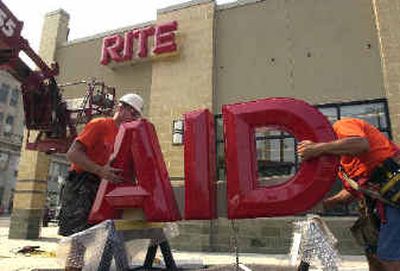Growth, but with less pain

CAMP HILL, Pa. — Expansion, which once threatened Rite Aid Corp.’s existence, is back on the drugstore chain’s agenda.
Having spent the past five years recovering from an accounting scandal that put its former CEO and other executives in prison, and after closing hundreds of stores in a huge restructuring, Rite Aid is thinking in terms of modest growth.
“We believe now that we have passed the mark of being stable and we don’t worry about the survival issue anymore,” Rite Aid’s chief executive and president Mary Sammons said in a recent interview. “If we’re going to have a future and the kind of future that we should have, we need to begin to grow again.”
Rite Aid, the nation’s third-largest drugstore chain, plans to open as many as 145 new and relocated stores across the country by March 2006. Currently, it operates about 3,380 stores, more than 600 fewer than it had in 1999.
That’s a slow pace compared to its larger competitors. Industry leader Walgreen Co. is building new stores at a rate of more than one a day in a campaign to have 7,000 stores by 2010, and CVS Corp. has agreed to purchase 1,260 Eckerd stores to add to its nearly 4,200 existing outlets.
Rite Aid’s expansion is tempered by high debt levels and a more cautious approach to growth than in the past. But the company’s re-emergence is what analyst Tom Goetzinger of Chicago-based Morningstar Inc. called a “minor miracle” after the company’s rapid expansion in the late 1990s went seriously awry.
Under its management team at the time, led by Martin Grass, the son of Rite Aid’s founder, the company spent billions to expand by about 1,500 stores over five years and purchase PCS Health Systems, a pharmacy benefits management company.
The spree left the company more than $6 billion in debt, the seriousness of which was hidden for at least two years because Grass and others falsified Rite Aid’s balance sheets to make the company look more profitable than it was. As a result of a federal investigation, Grass and three other former executives are in prison after pleading guilty to conspiracy. A fifth awaits sentencing on 10 criminal counts after being convicted by a jury.
When Sammons and other executives took over in December 1999, they discovered a disorganized chain that had overstated its revenues by at least $1.6 billion and was steadily losing customers. The company had no plans to expand its prescription business, according to Sammons, and stores had inconsistent marketing circulars, poorly stocked shelves and low employee morale.
The new managers began a restructuring that included closing 600 of Rite Aid’s worst-performing stores, shrinking the company’s payroll from nearly 90,000 to 72,000. By selling assets including PCS, which went for $1 billion, they pared down debt.
To bring back shoppers, Rite Aid has been buying customer prescription files from independent drugstores. Inside its own stores, it is promoting beauty and wellness products with circulars and displays of GNC vitamin and sports nutrition products. The company has also aggressively changed its merchandise mix with lower-priced store brands and remodeled hundreds of stores, paying close attention to appearance and aisle space.
Even with fewer stores, Rite Aid’s revenue rose from $13.3 billion to $16.6 billion in four years. And five months ago, the company completed its first profitable year since 1997.
Now, Rite Aid hopes to boost profits by building on well-established operations in its strongest markets, such as Baltimore, Philadelphia and southern California. Ten new Rite Aid stores are under construction, some of which could be finished as early as next month, and five more are being started next month, said company spokeswoman Karen Rugen.
Although Rite Aid is carrying a relatively large $3.7 billion in long-term debt — CVS’ debt totals about $750 million while Walgreen has practically none — Sammons insists it can afford to expand.
“I think if you look at how we finished off this last quarter, and the amount of cash on our balance sheet, our relationship with banks, I’d say we’re on really solid financial footing,” she said.
“The timing is right for us.”